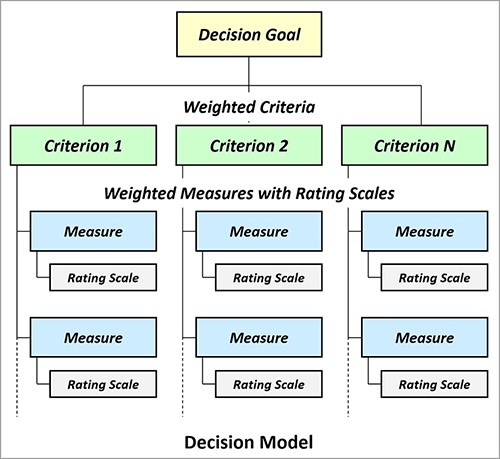Using Decision Models for Multi-Criteria Decision-Making

Buying a new home, relocating to a new city, making a healthcare decision for an aging family member – these are all multi-criteria decisions that can be complex and stressful when there are only one or two decision-makers. Presume for a moment that you and ten members of your extended family need to make a group decision. Better yet, not one of the decisions, but all of the decisions – by next week. Are you feeling the anxiety yet? This is what it can feel like during budget formulation time at a federal agency, when there are many competing priorities, differing views, and a sense of urgency.
As I mentioned in our last blog, budget formulation is best managed using a defined and transparent process. A key component of that process is the use of a decision model (also referred to as a scoring model). A decision model facilitates the evaluation and prioritization of alternatives against a set of weighted criteria.
What is a Decision Model?
Decision models consist of a goal, weighted criteria, measures (optional), and associated rating scales. They are designed to help decision-makers comprehensively and consistently assess and score the business value of competing alternatives that contribute to the decision goal.

Advantages of Decision Models
Decision models have distinct advantages over single metric prioritization techniques such as Return on Investment (ROI), to include:
- Balancing multiple quantitative and qualitative factors
- Ensuring a comprehensive assessment of each alternative
- Promoting cost vs. benefit analyses
- Providing better decision justification
- Enabling quick-reprioritization in response to changing business conditions
Decision Models for Budget Formulation
Regarding IT budget formulation, the weighted criteria in a decision model usually consist of strategic objectives, and the alternatives are often potential projects, programs, or enterprise initiatives. We have found that 4-7 strategic objectives are typically sufficient for most organizations to conduct a thorough and rich analysis of the alternatives. Often, the strategic objectives can be drawn directly from the organization’s strategic plan.
Depending on the complexity of the criteria, it may or may not be necessary to establish measures for each criterion, as the rating scales can be applied directly to the criteria in many situations. The rating scales, and supporting definitions, provide the basis for alternative scoring.
Does your organization make budget formulation decisions that would benefit from the use of a decision model?
© 2017 Definitive Business Solutions. All Rights Reserved.
John Sammarco has thirty-five years of experience leading, managing, and consulting to top public and private sector organizations, and has over twenty years of experience in facilitating complex group decisions. John founded Definitive Business Solutions in 2003, which provides world-class group decision-making solutions to increase efficiency, boost ROI, and reduce risk associated with business and technology investments. In 2016, John developed Definitive Pro™, which helps groups build consensus and make multi-criteria decisions.
